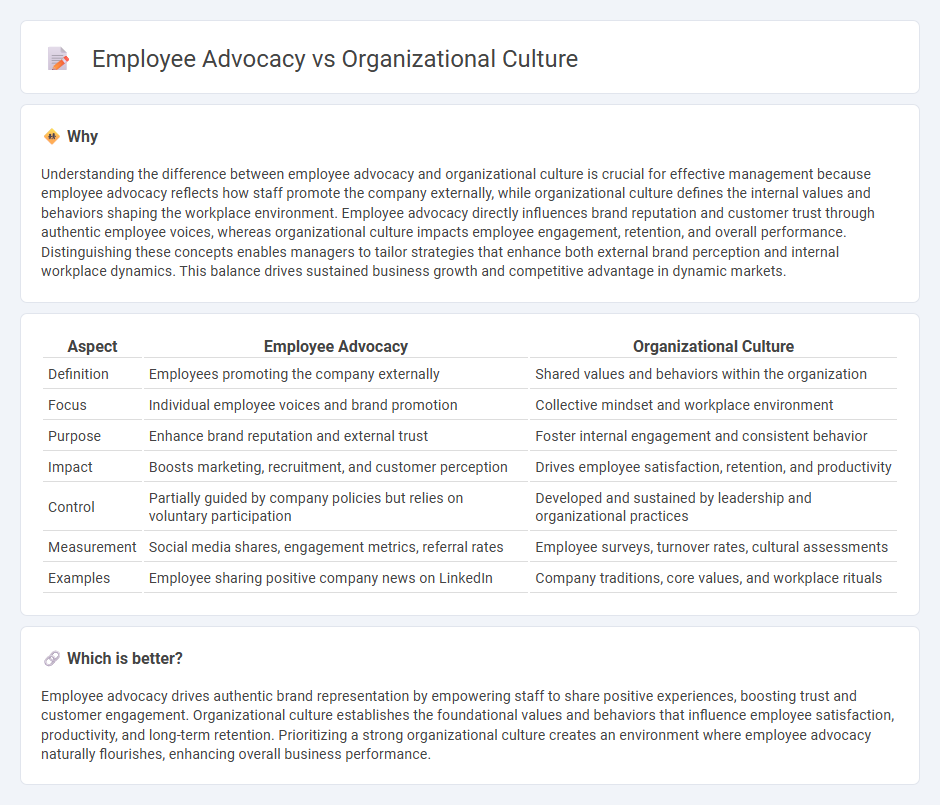
Employee advocacy involves employees actively promoting and supporting their company, enhancing brand reputation and trust. Organizational culture defines the shared values, beliefs, and behaviors that shape the work environment and influence employee engagement and performance. Discover how aligning employee advocacy with a strong organizational culture drives business success.
Why it is important
Understanding the difference between employee advocacy and organizational culture is crucial for effective management because employee advocacy reflects how staff promote the company externally, while organizational culture defines the internal values and behaviors shaping the workplace environment. Employee advocacy directly influences brand reputation and customer trust through authentic employee voices, whereas organizational culture impacts employee engagement, retention, and overall performance. Distinguishing these concepts enables managers to tailor strategies that enhance both external brand perception and internal workplace dynamics. This balance drives sustained business growth and competitive advantage in dynamic markets.
Comparison Table
| Aspect | Employee Advocacy | Organizational Culture |
|---|---|---|
| Definition | Employees promoting the company externally | Shared values and behaviors within the organization |
| Focus | Individual employee voices and brand promotion | Collective mindset and workplace environment |
| Purpose | Enhance brand reputation and external trust | Foster internal engagement and consistent behavior |
| Impact | Boosts marketing, recruitment, and customer perception | Drives employee satisfaction, retention, and productivity |
| Control | Partially guided by company policies but relies on voluntary participation | Developed and sustained by leadership and organizational practices |
| Measurement | Social media shares, engagement metrics, referral rates | Employee surveys, turnover rates, cultural assessments |
| Examples | Employee sharing positive company news on LinkedIn | Company traditions, core values, and workplace rituals |
Which is better?
Employee advocacy drives authentic brand representation by empowering staff to share positive experiences, boosting trust and customer engagement. Organizational culture establishes the foundational values and behaviors that influence employee satisfaction, productivity, and long-term retention. Prioritizing a strong organizational culture creates an environment where employee advocacy naturally flourishes, enhancing overall business performance.
Connection
Employee advocacy thrives in organizations with a strong, positive culture that fosters trust, engagement, and shared values. When employees feel aligned with the company's mission and supported by transparent communication, they become authentic brand ambassadors, driving reputation and business growth. A culture emphasizing collaboration and recognition amplifies advocacy efforts by encouraging proactive employee involvement and loyalty.
Key Terms
Shared Values
Organizational culture is defined by the shared values, beliefs, and norms that shape employee behavior and decision-making within a company. Employee advocacy emerges when individuals authentically promote these shared values, enhancing brand reputation and fostering trust both internally and externally. Discover how aligning organizational culture with employee advocacy drives engagement and business success.
Engagement
Organizational culture significantly shapes employee engagement by fostering values, beliefs, and practices that motivate staff participation and commitment. Employee advocacy reflects this engagement through active promotion and positive representation of the company on various platforms, boosting brand reputation and trust. Explore how aligning culture and advocacy strategies can enhance workforce satisfaction and business success.
Brand Ambassadorship
Organizational culture shapes employees' values, beliefs, and behaviors, directly influencing their willingness to serve as authentic brand ambassadors who embody the company's mission and vision. Employee advocacy amplifies brand presence by encouraging workers to share positive experiences, fostering trust and expanding reach through genuine social engagement. Discover how aligning culture with advocacy strategies can boost your brand's impact and employee engagement.
Source and External Links
The 4 Types of Organizational Culture & How to Design Change - This article discusses the four main types of organizational culture: Adhocracy, Clan, Hierarchy, and Market, and explains how each type influences an organization's dynamics and success.
Organizational culture: Definition, importance, and development - This blog post defines organizational culture and highlights its importance, while also detailing the four main types of organizational cultures and six dimensions that influence it.
Organizational Culture: Definition and Types - This article provides an overview of what organizational culture entails and explains the four main types identified by Quinn and Cameron: Clan, Adhocracy, Market, and Hierarchy cultures.
 dowidth.com
dowidth.com